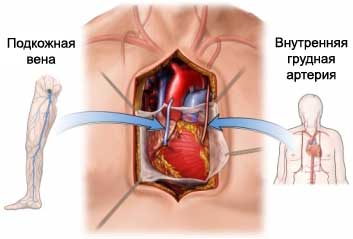Removal of veins for transplant – Isolation of the vessel
Description vein removal for transplantation
Vienna can sometimes be used to replace diseased arteries. The process of selection is called the release of the vessel.
To select frequently used veins in the legs. To open chest procedures, such as coronary artery bypass grafting (AKS), often used veins or other blood vessels chest.
Reasons for removal of veins for transplant
Patients atherosclerosis vascular plaque accumulates, which can block blood flow. Problems with coronary (heart) or the carotid arteries of the brain often can be solved, to crawl (bypass). Dedicated veins are most commonly used to bypass these blocked arteries.

Possible complications separation vessel
Complications are rare, but the procedure does not guarantee the absence of risk. Complications may include:
- Bleeding;
- Nerve Damage;
- Infection at the site of vein selection.
Factors, that may increase the risk of complications include:
- Smoking.
How is the selection of the vessel?
Preparation for the procedure
The necessary preparations for the release of the vessels will be determined by the primary procedure. In most cases this will be an operation on the heart or blood vessels, for which the patient is hospitalized and carefully examined.
Tell your doctor about taking any medications. A week before surgery, perhaps, you need to stop taking certain drugs:
- Aspirin or other anti-inflammatory drugs;
- Blood thinners, such as clopidogrel (Plaviks) or warfarin;
- Statins and medications to lower cholesterol;
- Some medications for diabetes.
During 8 hours before the procedure can not eat and drink.
Anesthesia
When you select the vessel is used general anesthesia, which supports the patient during an operation in a sleep state.
Procedure separation vessel
The traditional technique selection vessel
The skin is made a long incision, to open the entire length of the vein. The off to the side branches of the vein are tied and cut off. The desired Vienna will be removed. Then the skin is closed by sutures or staples.
Endoscopic release of the vessel equipment
At both ends the following two smaller veins notch. Special lengths, delicate instrument with a camera on the end (endoscope) is inserted through one of the incisions along the vein. With it, the vein is separated from the exhaust to the sides of blood vessels and surrounding tissue. Vienna then be removed through the second incision at the other end of the vein.
Immediately after isolation of the vessel
Perform basic operations. Your leg (or feet) They will be tightly bandaged, to prevent bleeding from the remaining vessels.
How long will the selection of the vessel?
Isolation of veins is usually part of the basic operation and does not increase its duration.
Isolation of the vessel – Will it hurt?
After isolating the vein using traditional technology can be a significant pain in the legs, incisional. To relieve pain doctor will give pain medicine.
The average time of stay in the hospital after discharge vessel
The stay in the hospital will depend on the basic procedure. Removing the veins does not extend stay.
Postoperative care
You will need to take care of the bandage and stitches. Ask the doctor, when it is safe to shower, bathe or expose the surgical site to water. To ensure that the recovery be sure to follow your doctor's instructions.
Contact a physician after discharge vessel
After discharge from the hospital need to see a doctor, if there was any of the following symptoms of:
- Signs of infection, including fever and chills;
- Redness, edema, strong pain, bleeding or discharge from the incision;
- Pain, which does not pass after taking pain medication appointed;
- Any discoloration legs;
- The leg is getting cold, numb, it felt tingling;
- Cough, shortness of breath or chest pain;
- Dizziness and weakness;
- Red, swollen, or warm to the touch of caviar.
